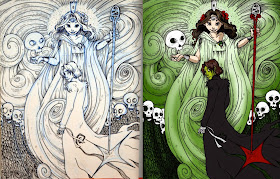L. Frank Baum's
The Scarecrow of Oz is the first Oz book that I read all by myself. It was a gift from my parents on my seventh birthday in 1974. I was in the second grade. (My mother believes it was
The Patchwork Girl of Oz that I first read by myself, but that's not the way I remember it. While it's true that I had been reading since the first grade, I still enjoyed our shared ritual of her reading the Oz books to me at bedtime. The only problem was that sometimes she would read only one chapter per night. When she started reading
Scarecrow, I was too impatient to stop at the end of a chapter, so I continued to read it by myself. I was off to the races!)
 |
| Inscription from my parents in 1974 |
|
The Scarecrow of Oz was my first introduction to two of my favorite
characters, Trot and Cap'n Bill. The girl and old sailor were probably familiar to many of Baum's readers when Reilly & Britton published
Scarecrow nearly 100 years ago on June 6, 1915. The two had many adventures together in Baum's "Borderlands of Oz" books,
The Sea Fairies (1911) and
Sky Island (1912). However, by the time I read
Scarecrow in 1974, those books had gone out of print. (I bought those books a few years later when an Oz Club member advertised them for sale on
The Oz Trading Post, which used to be a supplement to
The Baum Bugle. Alas, the
Post became obsolete in the age of the Internet and eBay.)
Trot and Cap'n Bill's adventures in
Scarecrow begin when they are boating along the coast of California. They get sucked into a giant whirlpool and dragged underwater. Luckily, they are saved from drowning by some mermaid friends from the duo's adventures in
The Sea Fairies:
"At first their fall was swift as an arrow, but presently they seemed to be going more moderately and Trot was almost sure that unseen arms were about her, supporting her and protecting her. She could see nothing, because the water filled her eyes and blurred her vision, but she clung fast to Cap'n Bill's sou'-wester, while other arms clung fast to her, and so they gradually sank down and down until a full stop was made, when they began to ascend again."
When Trot and Cap'n Bill come to their senses, they find themselves in an underwater cave and meet their first new friend, the Ork. As the story continues, they travel to the land of Mo and encounter the Bumpy Man and Button-Bright. While in Mo, they eat popcorn snow and drink lemonade rain. (Readers of
The Magical Monarch of Mo will recall that land's edible and drinkable precipitation.) Along their way they meet the Scarecrow, and of course they eventually find themselves in Oz.
 |
| Left to right: 1st printing (1915), later printing with dust jacket (circa 1946), Popular Edition (1940), Roycraft edition (1959), white edition (1964) |
Like so many of the Oz books,
The Scarecrow of Oz was reissued multiple times in various formats before the book's publisher faded out of existence.
 |
| Color plate from the 1st printing |
The earliest printings of
Scarecrow were issued with twelve color plates. But only the first printing has an advertisement on the verso of the title page listing titles in the Oz series through
The Scarecrow of Oz. That's the easiest way to identify a first printing by Reilly & Britton.
The second printing was issued two years later in 1917, and the verso of the half title page lists titles through
The Lost Princess of Oz. When the third printing came out in 1918, the list of titles went through
The Tin Woodman of Oz. Starting in 1919, the book was published by Reilly & Lee. Color plates were discontinued in 1934.
 |
| The first printing has an advertisement on the verso of the half title page listing titles in the Oz series through The Scarecrow of Oz |
 |
| The 1940 "Popular Edition" |
One of my favorite early variants of this title is the "Popular Edition" of 1940. This is a larger, thicker book with a new cover and dust jacket design by an unknown artist. This issue has only black and white illustrations (no color plates), and instead of being bound in cloth, it has paper-covered boards.
 |
| Library-style binding (mid-1940s) |
In the mid-1940s Reilly & Lee came out with a sturdy library-style
edition that was designed to better withstand heavy use and circulation.
The front cover and spine were printed in black only.
Another interesting variant was issued in 1959. This book was
bound in cloth, but there was no color
label – or any art at all – on the front cover.
Instead, it featured a new dust jacket design by "Roycraft." This was
part of an effort by the publisher to modernize the look of the series.
 |
| 1959 issue with Roycraft dust jacket |
The last variant published by Reilly & Lee is the "white edition" of 1964. This book was issued with no dust jacket at all. The full-color art was printed directly on white cloth. The front cover was designed by Dick Martin, and the back cover is a simplified version of the color plate reproduced above, with the Scarecrow's head, grasshopper, and some foliage against a red background.
 |
| This is the white edition of 1964 that I received for my seventh birthday |
For a detailed publishing history and bibliographic descriptions of early editions of
The Scarecrow of Oz, see the revised and enlarged edition of
Bibliographia Oziana, published by the
International Wizard of Oz Club in 1988. Also see
The Book Collector's Guide to L. Frank Baum and Oz by Paul Bienvenue (2009). The latter book was my primary source in writing this blog post.






















































